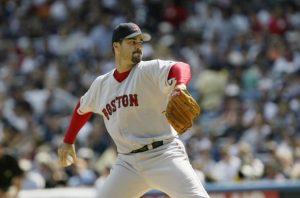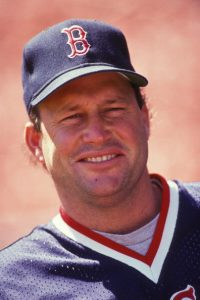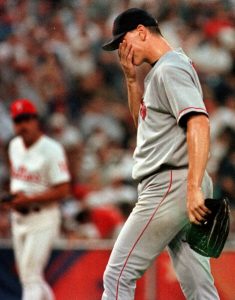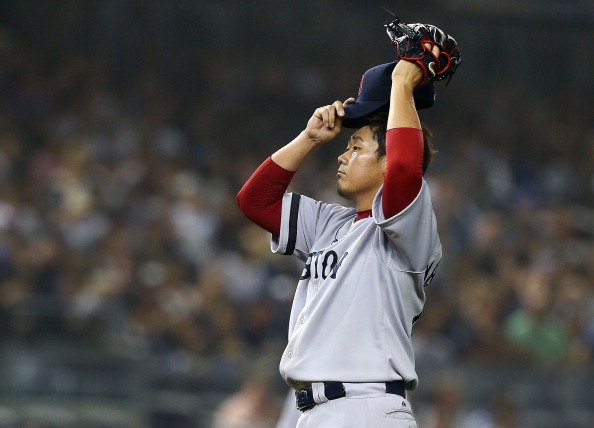Starting a new historical series of articles, I will cover the worst Red Sox to ever play at each position. This is the follow-up to my series of the five greatest Red Sox at each position. This one is even trickier, trying to find the worst player over the span of more than a century. I won’t bother with players who barely made an appearance. These articles will use some combination of guys who failed miserably in living up to a contract or hype, and those who just failed miserably.
Red Ruffing
Ruffing tops my list for what he did with the team versus what he did after leaving. Ruffing spent five full seasons in Boston and parts of two others. During that time he won 39 games against 96 losses! Despite this record of 57 games under .500, he ended up making the Hall of Fame. Yes, he is one of the weaker members in the Hall of Fame and probably doesn’t belong in there, but it goes to show what he did after.
After going 39-96 with a 4.61 ERA and 1.50 WHIP, just wretched numbers all around, Ruffing was sent to the Yankees. He ended up winning 231 games over parts of 15 seasons with the Yankees. He won 20 games in four consecutive seasons to close out the 1930’s. Ruffing certainly benefited from a potent Yankees lineup, but he pitched much better with the Yankees. That is why this bum comes in at number one.

Red Ruffing of the Boston Red Sox throwing a ball in 1925. (Photo by Sporting New and Rogers Photo Archive via Getty Images)
Daisuke Matsuzaka
It might seem strange to have a guy who finished in the top five of a Cy Young vote at number 2, but he earned it. Daisuke sat on the Red Sox roster, overpaid, for six seasons. Not wanting to lose on their investment, the Red Sox tried to fit him into the rotation year after year, deserving or not. Including the posting fee, Matsuzaka cost the Red Sox over 100 million dollars. For all that he only won 50 games.
Daisuke was one of the most hyped pitchers I have ever witnessed. He came from Japan with a “gyro ball” and a bunch of other phantom pitches he didn’t actually throw. He was also the most frustrating pitcher I have ever watched, nibbling a couple of inches off the plate once he got to two strikes and seemingly going 3-2 on every batter. As a result, Daisuke rarely went deep into games. In fact, in his good season with the team, 2008, Matsuzaka only averaged 5.2 innings pitched per start. Even when he was good, Daisuke taxed the bullpen and relied on them to close out his wins for several innings.
After winning 33 games over his first two seasons in the states, Daisuke won 17 over his last four seasons with Boston. During that stretch he was 17-22 with a 5.53 ERA and 1.54 WHIP. He also walked 4.5 batters per nine innings during that stretch. He was paid 37 million during those four years, on top of the high posting fee the Red Sox had to pay to even negotiate with him.
| Year | Tm | W | L | GS | CG | SHO | IP | H | ER | BB | SO | HBP | ||||
|---|---|---|---|---|---|---|---|---|---|---|---|---|---|---|---|---|
| 2007 | BOS | 15 | 12 | 4.40 | 32 | 1 | 0 | 204.2 | 191 | 100 | 80 | 201 | 13 | 1.324 | 3.5 | 8.8 |
| 2008 | BOS | 18 | 3 | 2.90 | 29 | 0 | 0 | 167.2 | 128 | 54 | 94 | 154 | 7 | 1.324 | 5.0 | 8.3 |
| 2009 | BOS | 4 | 6 | 5.76 | 12 | 0 | 0 | 59.1 | 81 | 38 | 30 | 54 | 2 | 1.871 | 4.6 | 8.2 |
| 2010 | BOS | 9 | 6 | 4.69 | 25 | 0 | 0 | 153.2 | 137 | 80 | 74 | 133 | 8 | 1.373 | 4.3 | 7.8 |
| 2011 | BOS | 3 | 3 | 5.30 | 7 | 0 | 0 | 37.1 | 32 | 22 | 23 | 26 | 1 | 1.473 | 5.5 | 6.3 |
| 2012 | BOS | 1 | 7 | 8.28 | 11 | 0 | 0 | 45.2 | 58 | 42 | 20 | 41 | 3 | 1.708 | 3.9 | 8.1 |
| 2013 | NYM | 3 | 3 | 4.42 | 7 | 0 | 0 | 38.2 | 32 | 19 | 16 | 33 | 5 | 1.241 | 3.7 | 7.7 |
| 2014 | NYM | 3 | 3 | 3.89 | 9 | 0 | 0 | 83.1 | 62 | 36 | 50 | 78 | 6 | 1.344 | 5.4 | 8.4 |
| BOS | BOS | 50 | 37 | 4.52 | 116 | 1 | 0 | 668.1 | 627 | 336 | 321 | 609 | 34 | 1.418 | 4.3 | 8.2 |
Jeff Suppan
In the nineties Jeff Suppan was a highly touted Red Sox prospect. A 2nd round pick of the team in 1993, Suppan climbed up the ladder successfully. He breezed through both A ball and AA before continuing his success in AAA, leading to his status as the Red Sox top pitching prospect. Suppan made the majors at the age of 20, which might have led to his not panning out. He had some level of success later on, but over parts of three seasons with the Sox to start his career, he posted a 5.99 ERA over 39 games.
After being okay with Kansas City, Suppan went to the Pirates in 2003. In Pittsburgh he won 10 games with a 3.57 ERA. So, what did the Red Sox do? They traded top prospect Freddy Sanchez amongst others to bring him back for the stretch run. Suppan failed the Red Sox again, posting a 5.57 ERA and being left off the playoff roster. He left for the Cardinals in the offseason and had his two best seasons of his career. In 2004 he finally did the best thing he ever did for the Red Sox; he got picked off third base by David Ortiz in the World Series as part of a double play.

Jeff Suppan of the Boston Red Sox throws against the New York Yankees at Yankee Stadium on September 7, 2003. (Photo by Chris Trotman/Getty Images)
Matt Young
Boston brought in Matt Young with talks of his “great arm”. Despite control problems and underwhelming numbers, the Red Sox gave Young a three-year contract for 6.35 million, big money in those days. Young was coming off a season with 18 losses, although his 3.51 ERA wasn’t so bad. However, since his all-star appearance in his rookie season, Young had gone 40-63 with a 4.52 ERA and 1.50 WHIP. Those are some pretty bad numbers for the 1980’s. Despite this, the Red Sox felt strongly enough in Young’s left arm they gave him a big contract,
Young is most famous for throwing a no-hitter that doesn’t count as one. In April of 1992 he threw an 8 inning no-hitter against the Indians. The reason it doesn’t go into the record books as a no-hitter is because he only pitched eight innings. The reason he only pitched eight innings, well, he lost. Matt Young walked seven batters that day and the Red Sox lost 2-1. This game pretty much sums up Young’s career.
Despite a three-year contract, the Sox released Young before the 1993 season began, getting two seasons out of him. In those two seasons Young was 3-11 with a 4.91 ERA and 1.61 WHIP. Young walked 5.4 batters per nine innings pitched.

Matt Young of the Boston Red Sox before a game on April 20, 1991 at Fenway Park.(Photo by Mitchell Layton/Getty Images)
Steve Avery
Avery came to the Red Sox following a successful stint with the Atlanta Braves. In Atlanta, he teamed with Greg Maddux, Tom Glavine and John Smoltz to form perhaps the best rotation in baseball. Avery won 72 games with a 3.83 ERA for the Braves over seven seasons. There were reasons to be skeptical however, as Avery’s play had dropped off in recent seasons. From 1991-93 he went 47-25 with a stellar 3.17 ERA. After a decent strike season, Avery fell off the next two years, going 14-23 with a 4.58 ERA. The Red Sox, needing help in their rotation, and a left-hander, signed Avery to a 4.85 million dollar contract with a second year vesting option.
Avery was brutal in 1997 for the Sox, finishing with a 6.42 ERA and 1.82 WHIP. One start shy of his option vesting for 1998, the Red Sox took him out of the rotation. The next month however, not agreeing with the morality of the move, Jimy Williams started Steve Avery for one final game, causing his option to take hold. Avery did do better his second season, going 10-7. He still was not good though, with a 5.02 ERA and 1.55 WHIP. In fact, Avery walked more batters than he struck out that season, 64 to 57. So his two-year totals with his fat contract came to a 5.64 ERA, 1.67 WHIP and -0.7 WAR.

Steve Avery leaves the game after giving up seven runs to the Philadelphia Phillies in the 3rd inning. (TOM MIHALEK/AFP/Getty Images)
Dishonorable Mention:
Mike Smithson, Vaughn Eshelman, John Smoltz, Mike Torrez, Matt Clement, Brian Rose, Gordon Rhodes, Jack Russell
